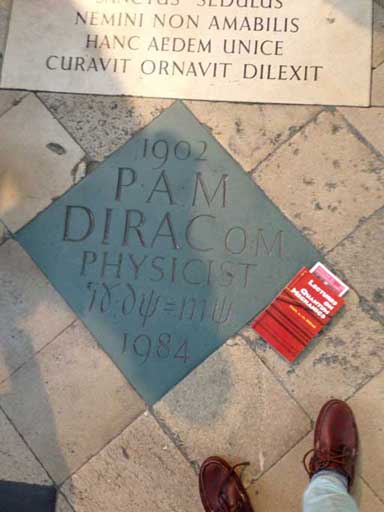
Five steps to my left and I will be stood over what remains of Charles Darwin. Four steps forward and I will come face to face with the death mask of Issac Newton. But it will take a keener eye to spot the object of my pilgrimage. Set neatly in the floor between Newton and Darwin is a small, unremarkable stone square about twice the size of my head. This is the nation’s memorial to the greatest British physicist since Newton and the man behind much of my final year of university physics; Paul A. M. Dirac. I have come to pay homage and end up spending a while just sat watching tourists pass the stone. Despite its simplicity this stone square is surely the most effective and beautiful memorial in the Abbey.
Kings, Queens and statesmen have relied on the skill of artists to convey, perhaps fabricate, a sense of their importance and success in life. Dirac’s memorial displays the power and beauty of his life's work with just the 6 letters that form his most famous equation; the Dirac Equation. This is his own handiwork. To describe in so precise a form the motion and very existence of all fundamental particles of nature, the same stuff of which we are made, is an act of uncommon genius. For Dirac, however, it may also have been an uncommon act of sacrifice; the dedication of his life.
I have with me, to aid my pilgrimage, a copy of Dirac’s Lectures on Quantum Mechanics in which he lays out in just 87 pages the mathematical ideas that lead to his equation. The ordering and logic of Dirac’s prose is impressive and carefully chosen. If asked by a student to clarify a point during a lecture he would simply repeat what he had said, word for word, and continue with the lecture. As far as he was concerned, he had already expressed the idea as clearly as it could be stated.
He was just as inexpressive in his personal life, speaking only when necessary and answering with one word sentences. So private was he that many of his closest friends never knew what his middle initials – A. M. – stood for (it’s Adrien Maurice). In this sense Dirac embodied his own subject of physics with his life. Direct and to the point, never more than necessary.
Wandering further around the Abbey I find myself in Poets Corner, final resting place of Charles Dickens, Alfred Lord Tennyson and other greats, and can't help but wonder who chose the better path in life. Certainly, there would be some buried in Poets Corner who would be quite hostile to the work of the scientists buried nearby.
The clock strikes four and the singers of the famous Westminster Boys Choir begin their daily service, their hymns reaching into every nook of the Abbey, exhorting listeners to direct their attention to heavenly matters. “There is no equation for the salvation of your soul,” they seem to say, although such arguments would hold little sway with Dirac, an ardent atheist and humanist.
The dead poets’ concern, however, would not be heaven but the heart; strangled, they might say, by the constraints of scientific rigour. This argument was most strongly made by William Wordsworth, himself memorialised in the Abbey;
Sweet is the lore which nature brings
Our meddling intellect
Mishaps the beauteous form of things
We murder to dissect
Part stanza, part slap, this is a direct attack on those who, like Dirac, dedicate their lives to science. When Dirac uses his equation to dissect the universe, does he also murder it? Is a life lived for science empty of beauty, of true meaning? Was Dirac’s?
The question cuts to the very heart of what has been troubling me since the end of my physics degree three weeks ago and what brings me here to the Abbey; was all this science worth it? Hidden to most visitors, this debate seems to wage in the Abbey itself. The Romantic poets vs the materialist scientists. Can they be reconciled?
Oscar Wilde, a much too outlandish poet to find himself in the sacred vaults of Westminster Abbey, famously declared, “all art is quite useless”. He argued that it was beautiful precisely because of this uselessness, because it was done for its own sake, not corrupted by practical concern. Perhaps the problem of science, and I know this sounds strange, is precisely the fact that it is quite useful. Often very useful. There was never a disease cured by a novel nor a planet probed by a poem but in being useful, science runs a risk that art does not; that it ceases to be for its own sake. This makes it better at attracting research grants but could explain something of why science is seen as an ultimately unfulfilling pursuit by many.
Can science be rescued? Is it possible to find the beauty of art within science? The Bristolian commemorated by that diamond stone and equation could have something to teach us. Although quite literal minded and blunt in his approach to life, Dirac’s idea of science was of science as an art, with mathematics his brush and his paint. He taught students always to pursue beauty in their work and would often reject proposed theories on the basis that they weren't beautiful enough. His approach to physics was to play with abstract, pure mathematics and see if any physics popped up. His underlying belief, almost religious in its strength, was that the laws of nature should be beautiful and simple.
Dirac’s field, quantum mechanics, is notoriously complicated. Particles are also waves, electrons are said to be in more than one place at a time, even in more than one universe at a time. Obtaining useful results from this often requires crude approximations and simplifications. It seems that at its most fundamental, physics is at its most useless. This may be the spirit in which the heart of science can be rediscovered. Could science pursued for its own sake, the less useful the better, be not just a way to better equations but to rediscover a sense of beauty in the subject?
The choir has finished and I realise I'm at risk of staying for a church service. I perform one quick lap of the Abbey before heading out into the warm evening. I have no definite answers but I wouldn't expect any certainties when trying to understand a quantum physicist like Dirac. Nevertheless, my secular pilgrimage has given me a glimpse of these Two Tribes in silent war. Could Dirac's belief in the beauty of physics and science for its own sake provide a bridge between the two?
My head full of thoughts, I leave Westminster Abbey to its more traditional pilgrims.

